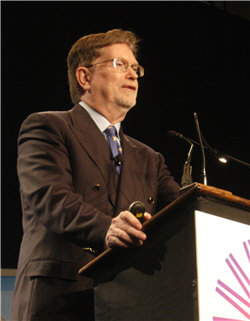SC07 Day 4: George Smoot listens for the big bang


These variations were first noticed by the COBE satellite in the early '90s, and subsequent observations have yielded more detailed measurements. The latest satellite (named Planck) is scheduled to launch next year. With this kind of data, scientists can run enormous simulations to explore how these superstructures formed and predict what's going to happen to the universe in the future.
Smoot took the audience through a virtual tour of the universe, stopping at an intersection of several "filaments" where thousands of galaxies have coalesced. There are only 100,000 or so such intersections in our universe, according to Smoot. "This would be a fairly interesting place to be."
The big bang created an effect much like dropping a pebble into a pond. An acoustic-like shock wave continues to spread out from that point of origin. The spherical surface of the wave, the "last scattering surface" is the limit of what we can observe. It dates back to about 400K years after the big bang, when the first atoms were able to form. For reasons as yet unexplained, this surface is not slowing down under the influence of gravity, but is actually accelerating. Understanding why this is happening is one of the great mysteries of our time, and supercomputers are helping scientists like Smoot to unlock it.